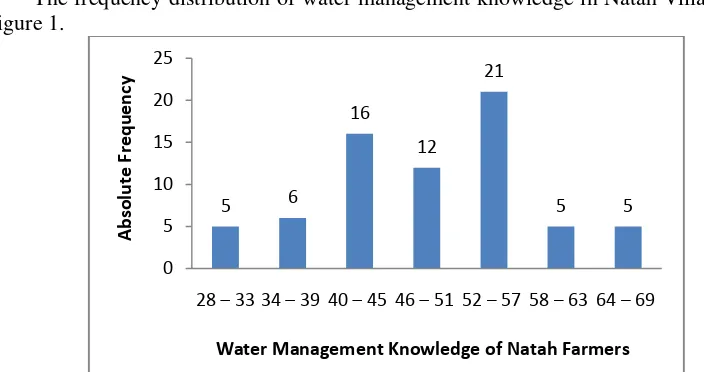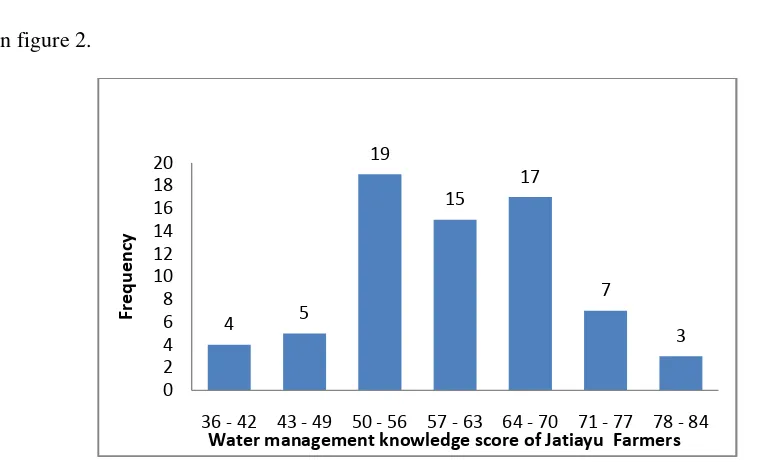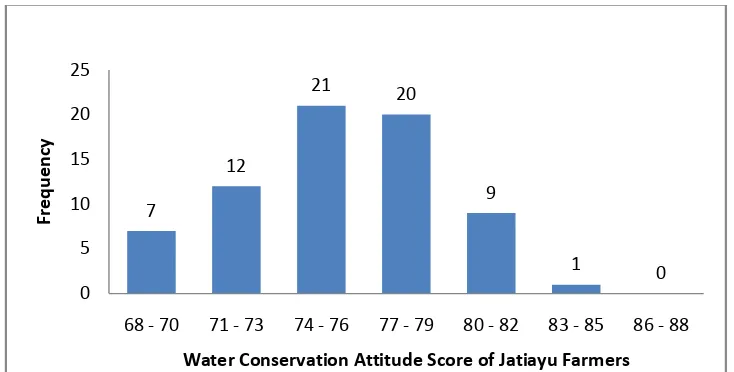BE-19
THE COMPARISON OF WATER MANAGEMENT KNOWLEDGE
AND WATER CONSERVATION ATTITUDE
ON FARMERS AT GUNUNG KIDUL REGENCY
Diana Vivanti1, Supriyatin1, RizchaPrawestriningrum2
1
Lecture at Department of Biology State University of Jakarta
2
Student at Department of Biology State University of Jakarta
Abstract
This research aimed to observe the difference of water management knowledge and water conservation attitude on farmers of Natah Village and Jatiayu Village at GunungKidul Regency, DI Yogyakarta Province. These two villages are karst area with the calcareous soil and different topography. Natah village has a few water soil than Jatiayu village. These differences might influence the water management knowledge and water attitude conservation on farmers. This research was conducted on April-Mei 2012. The method was descriptive quantitative method with 140 samples of farmers taken by simple random sampling and t test data analysis. The result of this study was water management knowledge and water conservation attitude of farmer at Jatiayu village was higher than Natah village. This research concluded that Natah village with a water soil limitation did not build a better water management knowledge and water conservation attitude. The role of GunungKidul Regency Government is important in managing water management knowledge and water conservation attitude on farmers especially in facing the climate change.
Key words: water management knowledge, water conservation attitude
INTRODUCTION
The diversity of geographic regions led to the availability of water in each different area. There are areas that are often flooded lowlands such as indensely populated, but there are also areas tha tare prone to drought andlack of water especially in the dry season. Areas that are often experience drought usually is an area that has little rainfall and soil conditions that are difficult to absorb rainwater, such as ground limestone which located in areas of karst. One cause of ground limestone is difficult to collect rain water because of its constituent materials are hard rock so it is difficult to process water infiltration.
A small area on the island of Java is the karst areas which is often experience a water crisis that are Natah village and Jatiayu Village, Gunung Kidul Regency, Yogyakarta. Natah village has a land condition with water supply less than Jatiayu village. Beside the government's efforts in water management, it required an awareness of the local community to undertake water conservation in the region. Without the active participation of the community, conservation efforts that have been made by the government will be futile.
concerning the management of water measured from farmers understanding in using water wisely. Knowledge is the result of human knowing about something, or any other actions of humans to understand an object that it faces or the result of human efforts to understand a particular objec t(Surajiyo, 2007). Attitudes related to the extent of one's knowledge of the object at hand. People who do not have knowledge of an object are usually not going to have a positive attitude toward the object.
Knowledge of water management and water conservation attitudes of farmers is necessary, more over in facing the climate change due to global warming. These global issues have made the climate can be so extreme in rainy season and in dry season. Long dry season will be trouble some life, because agriculture could not take place, as a result in food shortages. Knowledge of water management and wise water conservation attitude need to be developed to deal with the extreme drought.
Based on this, the farmers in karst areas expected have good knowledge about water management that can influence positive attitudes towards water conservation efforts. Therefore, it is necessary to examine a research related to the attitude of farmers towards water conservation in terms of the level of knowledge of water management in the Natah village which is geographically different from Jatiayu village.
The purpose of this study was to determine differences in water management knowledge and attitudes of farmers towards water conservation farmer in the Natah village and Jatiayu village, Gunung Kidul Regency in facing the climate change.
RESEARCH METHOD
This study aimed to measure the difference in water management knowledge and attitudes of farmers towards water conservation in the Natah village and Jatiayu village, Gunung Kidul Regencyin the face of climate change. This research was conducted in the Natah village and Jatiayu village, Gunung Kidul Regency Yogyakarta, in April-May 2012. The method used is descriptive method with survey techniques. The variables studied were the level of knowledge about water managementas an independent variable (X) and the attitude of farmers towards water conservation as the dependent variable (Y).
The target population of this study is farmers in Gunung Kidul Regency. The affordable population is farmers in Natah village and Jatiayu village, Gunung Kidul. Target and affordable population was selected by purposive sampling. From each village, 5 neighborhood group were selected in Cluster Random Sampling. From these 5 neighborhood group, 70 samples were selected from each village by simple random sampling, so the entire amount of the sample was 140 farmers.
This study used two data variables, namely water management knowledge and attitudes of farmers towards water conservation. Preparation of instruments developed knowledge of water conservation in the true-false test with two alternative answers (right or wrong). Instrument to measure attitudes towards water conservation is a Likert scale, with five alternative answers. Validation is done using the content validity Pearson Product Moment formula. Reliability testing in this study using Cronbach alpha formula.
Data analysis began with the prerequisite test, normality testwith Kolmogorov-Smirnov test, and homogenity test with Test-F. The different test on knowledge of water management and water conservation attitudes in Natah village and Jatiayu village performed by t-test.
RESULT AND DISCUSSION Result
1. Water management knowledge on farmers at Natah and Jatiayu Village
BE-21 belows:
Table 1.The descriptive statistic of water management knowledge at Natah and Jatiayu Village No Descriptive Statistic Natah Village Jatiayu Village
1 Maximum score 69 80
2 Minimum score 29 36
3 Mean Score 48.77 59.93
From the table above, the maximum, minimum and mean score of water management knowledge at Jatiayu Village are higher than Natah Village. The difference score between these 2 villages on the maximumscore is 11, minimum score is 7, and mean score is 11.16
The frequency distribution of water management knowledge in Natah Village is shown in Figure 1.
Figure 1.The Diagram of Water Management Knowledge score of Farmers at Natah Village Based on the Fig 1, it appeared that in Natah village, the highest score of water management knowledge is found in the fifth interval, 52-57 with 21 farmers (30%). The lowest score of water management knowledge is in the first interval (28-33), sixth(58-63) and seventh (64-69), each with 5 farmers (7%).
The average score in water management knowledge is 48.77 which is present in the interval of 44-51.The respondents who has scores below average are 27 farmers, who has scored at average are 12 farmers and above the average score 31 farmers. This implied that there are lots of farmers who got score above the average score. It indicated that farmers in Natah Village know well about water management knowledge.
Based on the Fig 2, it appears that in Jatiayu village the highest score of water management is found in the third interval, 50-56 withtotal score 19 farmers (30%). The lowest score of water management was in the first interval (28-33) with 4 farmers (5.71%) and in the seventh interval (78-84) with 3 farmers (4.29%).
The average score of water management knowledge on Jatiayu farmers is 59.33 which is present at the interval of 57-63.The respondents who has scores below average are 28 people, who has scored at average are 15farmers and above the average score 27 farmers. This implies that farmers who got below and above mean score are equal. It indicated that water management knowledge in Jatiayu farmers are quiet good
The frequency distribution of water management knowledge in Jatiayu Village is shown
in figure 2.
Figure 2.The Diagram of Water Management Knowledge score of Farmers at Jatiayu Village 2. Water Conservation Attitude on Farmes at Natah and Jatiayu Village
The score of water management knowledge at Natah and Jatiayu Village are shown in Table 2belows:
Table 2. The descriptive statistic of water conservation attitude at Natah and Jatiayu Village No Descriptive Statistic Natah Village Jatiayu Village
1 Maximum score 83 83
2 Minimum score 59 68
3 Mean Score 70.87 75.71
From the data in table 2, it appears that the maximum water conservation attitude between Natah and Jatiayu village has an equal score 83. Minimum scores and average score at Jatiayu village is higher than at Natah village. The difference score in the minimum score is 8 and in the mean score is 4.84.
The frequency distribution of water conservation attitude of farmers atNatah Village is shown in Figure 3.
Figure 3.The Diagram of Water Conservation Attitude score of Farmers at Natah Village
4 5
Water management knowledge score of Jatiayu Farmers
6 6
BE-23
From Fig 3, it appears that the highest frequency on water conservation attitude farmers in Natah village is in the fourth interval (71-74) with 28 farmers (40%). The lowest frequency is in the seventh interval (83-86) with 1 farmer (1%)
The average score of water conservation attitude was 70.87 which was included in the good behavior category. Farmers who got score below the average score and the average score are 28 farmers; while there were 14 farmers who got above average people. This meant many farmers have score the same as the average score and the above score. It indicated that farmers on Natah village had a quiet good water conservation attitude.
From the Figure 4, the highest frequency of water conservation attitude at Jatiayu village was in the fourth interval (74-76) with 21 farmers (40%). The lowest frequency was in the seventh interval (83-85) with 1 farmer (1%)
Figure 3.The Diagram of Water Conservation Attitude score of Farmers at Jatiayu Village The average score of water conservation attitude at Jatiayu was 75.71 which was included in the good behavior category. Farmers who got score below the average score were 19 farmers, the same as the average score are 21 farmers and above the average score are 30 farmers. This meant that most farmers had good water conservation attitude.
Discussion
1. The Difference of farmerswater management knowledge at Natah and Jatiayu Village
Based on the t-test analysis, there was a significant difference in water management knowledge between Natah andJatiayu farmers. The average score of water management knowledge in Jatiayu village was 59.93 while in Natah village was 48.77. The score of Jatiayu farmers was higher than Natah farmers. There were factors that influence these differences, such as the land condition. Although these two villages are in the GunungKidul Region, but water source in Jatiayu Village is greater than Natah Village. The water availability in Jatiayu Village made the farmers do the plantation and develop agriculture system better than Natah Village. In the dry season farmers in Jatiayu Village still could do farming because there are still enough available water.
It is difference with the Natah Village which had limited water availability. Natah village is a hill area with latosol mud type and volcanic rock which is very difficult for water storage. The difference of the land area between these two villages made differences in forming
7
the knowledge of water management knowledge. The condition of Jatiayu Village formed farmers knowledge better in water management than Natah farmers. These fact finding was also supported by Anderson (2001) who declared that every man have any experience which could be collected in a knowledge collection. These knowledge could be develop in a new systematic knowledge or science.
Natah farmers did not have good experience in water management knowledge so that their knowledge did not develop. Their knowledge are lower than the Jatiayu farmers. The condition of the land in Natah village make farmers just accept all the conditions and less trying. Especially in the dry season with limited water management knowledge, farmers did not know what should to do, therefore farmers of Natah Village are lack of water management knowledge. Their knowledge is just limited in saving rain water management knowledge, which is not enough for farming in the dry season.
2. The difference of farmer’s water conservation attitude in Natah and Jatiayu Village From the t-test analysis, in testing the difference of farmers attitude towards water conservation in Natah and Jatiayu Village, showed a significantly different. The difference of the average of water management knowledge conservation attitude in Jatiayu Village (75.71) is higher than in Natah Village (70.78).
The difference of water conservation attitude between these two villages related to the water management knowledge. The land condition difference build different water conservation attitude. Jatiayu land condition which is better than Natah had also bring better attitude towards water management knowledge conservation than Natah farmers
Realizing the condition of the land, Jatiayu farmers have to manage water saving in purpose to keep agricultural activity in the dry season. Basically, the condition of water saving at Jatiayu village is quiet available so water conservation attitude of the farmers are also good. It is as stated by Yustina (2006) attitude is a willingness and the readiness to respond to any value or object and respond to various objects affected by experience that deals with mental state, the psychological and cultural matters. Attitude is defined as a reaction against an individual stimulus or an environment.
Natah village with its lacked water supply environmental conditions, especially over in the dry season, made farmers to be less concerned with water conservation. The Natah village with soil types could not store ground water, farmers do not know much how to be behave in water conservation. Farmers rely on reservoirs as a source of water and make water storage while in the rainy season. While in filtration wells also could not be expected because of less rain fall and poor soil conditions in water storage. This condition do not support and formed farmers water conservation attitude.
Attitudes are formed from the interaction of individuals with each other. These interactions will form the pattern of individual attitudes towards a particular object that it faces. In pattern formation attitude regardless of the various factors that influence it, such as: personal experience, culture (environment), mass media, educational institutions and religious institutions (Anwar, 2007).
CONCLUSION AND SUGGESTION
Based on the results obtained the following conclusions:
Knowledge of water management and water conservation attitudes of farmers in Jatiayu village is higher than in Natah Village
There are significant differences of water management knowledge and water conservation attitudes among farmers in Natah village and Jatiayu Village
BE-25
farmers towards water conservation. While the region which is less of water, does not form good water management knowledge and water management knowledge conservation attitudes. The role of local government is very important because the geographic areas and natural conditions that are less water absorption, the community should be actively trying to improve their knowledge of water management that have a positive attitude in water conservation, especially in facing the climate change.
REFERENCES
Anengsih, Aan. 2003. Hubungan Antara Intensifikasi Pertanian dengan Produktivitas Padi di Desa Cingkuang, Kecamatan Palimana, Kabupaten Cirebon. Skripsi, UNJ, Jakarta. Arsyad, S. 2000. Konservasi Tanah dan Air. Bogor: IPB Press
Azwar, Saifuddin. 2007. Sikap Manusia Teori dan Pengukurannya. Edisi ke 2. Yogyakarta: Pustaka Pelajar
Budihardjo, E. 2005. Peluang Pengelolaan Lingkungan Hidup di Daerah Dalam Rangka Penerapan Undang-Undang Nomor 22 Tahun 1999 Tentang Pemerintahan Daerah. Jakarta: Bapedalda
Darmawijaya M, Isa. 2000. Klasifikasi Tanah Dasar Teori Bagi Peneliti Tanah dan Pelaksana Pertanian di Indonesia. Yogyakarta: Gadjah Mada University Press
Indrawan, Mochamad, Richard B. Primarck dan Jatna Supriatna. 2007. Biologi Konservasi. Edisi Revisi. Jakarta: Yayasan Obor Indonesia
Manik, Karden Eddy Sontang. 2004. Pengelolaan Lingkungan Hidup. Jakarta: Penerbit Djambatan
Parsons A., Richards, dkk. 2001. Educational Psycology, A Practicioner-Reseacher Model of Teaching. Canada: Wasworth
Purba, Jonny. 2002. Pengelolaan Lingkungan Sosial. Jakarta: Yayasan Obor Indonesia
Rahayu, Astuti. 2008. Kabupaten Gunung Kidul (Sebuah Kajian Wilayah Yang Kurang Berkembang. Tesis, Universitas Diponogoro, Semarang.
Salikin, Karwan. 2003. Sistem Pertanian Berkelanjutan. Surabaya: Kanisius
Sugiyono. 2008. Penelitian Pendidikan (Pendekatan Kuantitatif, Kualitatif dan R & D). Bandung: Alfabeta
Surajiyo.2008.Filsafat Ilmu dan Perkembangannya di Indonesia. Jakarta: Bumi Aksara. Suripin. 2001. Pelestarian Sumber Daya Air dan Tanah. Yogyakarta: Andi Yogyakarta
Suryatmaja, Hatma. 2002. Konservasi Tanah di Kawasan Karst Gunung Kidul. Diunduh dari http://www.mayong.staff.ugm.ac.id/artikel_pdf pada 2 Agustus 2011. Pukul 13.10 WIB Sutanto, Rahman. 2007. Dasar-Dasar Ilmu Tanah (Konsep dan Kenyataan). Yogyakarta:
Kanisius
Yustina. 2006. Hubungan Pengetahuan Lingkungan dengan Persepsi, Sikap, Minat dalam Pengelolaan Lingkungan Hidup pada Guru Sekolah Dasar di Kota Pekanbaru. Jurnal Biogenesis. Vol 2(2): 67-71. Desember 2006


